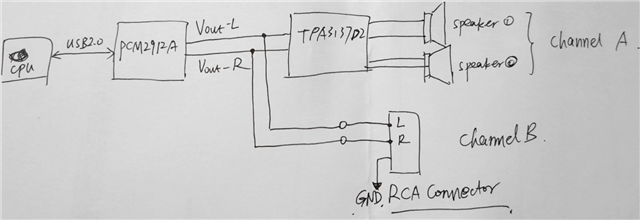- Ask a related questionWhat is a related question?A related question is a question created from another question. When the related question is created, it will be automatically linked to the original question.
This thread has been locked.
If you have a related question, please click the "Ask a related question" button in the top right corner. The newly created question will be automatically linked to this question.
Hi Ti team,
Our audio signalchain is : x86 CPU ---(HDA)---> codec ALC892 --(two line out)-> TPA3137 --> two stereo L/R differential outputs audio..
http://chipset-ic.com/datasheet/ALC892.pdf
now we hope to change to USB interfaced codec like PCM2912A. I am not familiar with audio things, some questions to consult:
1. ALC892 support 44.1K/48K/96K/192K sample rate, while PCM2912A max support 48 kHz. Not sure whether this will be enough. we use 44.1K now, but may upgrade to higher sample rate.
2. ALC892 support 16/20/24bit , while while PCM2912A support 16bit DAC. Not sure whether this resolution will be enough.
3. PCM2912A only have one stereo output, so I need to use two PCM2912A ? or other solutions?
4. any other suggestions are welcome.
Thanks!
Hi,
44.1kHz and 48kHz are the most typical audio sampling rates. Anything higher is typically used in only pro audio applications. If you're using 44.1kHz now, you really won't gain much by going to a higher rate; 48kHz is fine.
Whether a bit depth will "Be enough" strongly depends on your application. Theoretically there is a significant quality difference between 16 and 24 bit audio, however in the real world noise and other imperfections bring that difference very close together. It's a similar answer to your first question: for professional audio applications you would want to go higher, but that isn't always necessary. If you have a target SNR, then you can more definitively say if a certain bit depth is enough.
All of our USB codecs have a single stereo pair output, so yes you would need 2 devices if you wanted to have the two stereo pairs you had before.
Best regards,
Jeff McPherson
hi Jeff, thanks for answer. we would keep 44.1k and 16bit as a baseline. Some further consulting.
1. I check with SE, the two 2 stereo pairs (named stereo pair A and B) have detialed requirementslike this:
channel A should be bufferred enough to drive two 3W speakers (A_left+/-, and A_right+/-), so we use TPA3137D2.
channel B can be simply un-bufferred Line-out, connected to RAC conn.
Since TI's codec have ONE stereo pair output. can I connect as below? will there be interference to each other channels' signal ?

2. I noticed Ti's usb codec have USB1.1 or USB2.0. USB 1.1 support 12Mbps, how shoulld I calculate will this bitrate be fast enough for our application?
4. Traditionally, PC motherboard use HDA codec,but this will need BIOS(driver) cooperation. USB codec is much more convenient since CPU will see it as a standard usb device. Is there any weakness on usb codec (seems not widely used)?
Thanks again!
Hi,
1) I would buffer the output of Channel B so that the codec sees a high load impedance, but otherwise there shouldn't be an issue here.
2) 44.1k is very typical for USB audio so I don't think 1.1 or 2.0 will make much of a difference here.
3) I don't understand what's being asked here. Can you elaborate?
4) The reason it's not as widely used is that typically the CPU or some other peripheral processor will handle the audio and convert it into I2S to then integrate into an audio amplifier. The USB codec is a little more niche, but it does provide the convenience of interfacing with USB so it's not weaker than other options, it's just a different application. The CPU will see the codec as any other audio device.
Best regards,
Jeff McPherson